Does Food Shopping Behaviour Determine Food Waste Vulnerability in Private Households? Quantitative Analysis on Case Studies from Germany
Abstract
1. Introduction
2. State of Research
2.1. Food Waste—Definition and Quantification
2.2. Private Households and Food Shopping Habits
3. Goals and Hypotheses
- to understand food waste vulnerabilities in private households not only as practices in the households themselves, but also as the result of upstream purchasing processes and loyalties to specific purchasing formats. These vulnerabilities are captured below in the form of self-assessments of how frequently food waste is generated in private households.
- whether different purchasing formats also trigger different waste vulnerabilities of their products for private households via their prices, quality, freshness or packaging sizes.
- to place food waste vulnerability not only in a factual, personal or temporal context, but also in a (geographically) spatially variable context. This spatial context may include, for example, different settlement patterns (rural versus urban), the temporal-spatial effort required for food purchases and different forms of transport mobility.
- to mirror the results for private households with best-case responses on food waste avoidance offers in retail and primary production. The latter are derived from expert interviews.
4. Methodology
4.1. Case Study and Sample
4.2. Data Preparation
4.3. Network
4.4. Expert Discussions
5. Results
5.1. Private Households
5.2. Original Producers and Marketers—Feedback for Households
6. Discussion and Implications
6.1. Approach
6.2. Integration into the State of Research
7. Conclusions
8. Limitations
Funding
Institutional Review Board Statement
Informed Consent Statement
Data Availability Statement
Conflicts of Interest
Appendix A
| I go shopping in discounters (Aldi, Lidl, Penny). I go shopping in supermarkets (Edeka, Sky Rewe). I usually think about what I want to buy before I go shopping. I make a shopping list before I buy food. I plan my meals for a few days in advance, so I can shop in a more targeted way. I like to cook and buy my groceries for this purpose. I always buy all my groceries from one shop of my choice. I go to the shop closest to my home. I go to the shop closest to my place of work. I want to be able to reach the shop easily by car. I want to be able to reach the shop easily on foot. I want to be able to reach the shop easily by bicycle. When shopping for groceries, the price is most important to me. Fresh products are important to me. Organic products are important to me. I sometimes forget something in the fridge. I like to buy food spontaneously. Shopping for food is simply a MUST for me. What I (we) eat at home I is often a last-minute decision. I like to eat with other people. I use advertising leaflets from supermarkets and discounters to select special offers. Especially since COVID-19, I have stockpiled more food in the form of jars and canned goods. I like to eat in Restaurants. If there are any leftovers, I have them packed up in the restaurant to take away. I like always having plenty of food at home. In my home everything is always eaten up. I have a guilty conscience when I have to throw food away. The appearance of fruit and vegetables is important for my purchase decision. When I go shopping, I choose food products with a long best-before date. I dispose of suitable food waste in the organic waste bin and/or in the compost. If food is left over, I also eat it later. I freeze food to preserve it. I buy products that come from the ‘region’. In my childhood, food waste was an important topic in the family. I need variety in my food. I am good at estimating how much food I need in the household. I also use other shopping alternatives like online grocery shopping on my PC. I also use other shopping alternatives like a village/farm shop. I also use other shopping alternatives like a weekly market. I follow media reports on the topic food. 1 = not at all true; 2 = seldom true; 3 = sometimes true; 4 = often true; 5 = totally true; very often true |
| How many rooms do you have in your apartment besides kitchen and bathroom? How many cars do you have in your household? How do you dispose of organic waste at home? (residual waste bin; organic waste bin; compost; sink; toilet; animal food; another option) What was the last food you threw away at home and what do you remember? (fruit, vegetable, bread, drink, other baked goods, sausage, meat, dairy product, ready meal, other item) Why did you throw this food away? (too large a package, rotten/mouldy, do not like the taste(anymore), best before date exceeded, too hard, mispurchase, forgotten in the cupboard, appearance no longer good, another option= Where did you get this food from? (supermarket, discounter, village shop, farm shop, weekly market, hypermarket, on the internet, own production e.g., from garden, another option) How often does food waste (no peel or bone residues) occur in your household? (never, daily, several times a week, weekly, several times a month, monthly, less often) Who produces food waste in your household? (yourself, partner, children in the household, guests in the household, others) |
| Fruit and vegetables are sometimes thrown away in my house. Dairy products such as yoghurt or cheese are sometimes thrown away. Bread is sometimes thrown away. Packaged food is sometimes thrown away. 1 = not at all true; 2 = seldom true; 3 = sometimes true; 4 = often true; 5 = totally true; very often true |
| On average, how often do you buy food for your household? (daily, three to four times a week, twice a week, once a week, fortnightly, less often) Where do you mainly buy food for your household? How much time do you usually need to get to the nearest food supplier of your choice? (Indicate in minutes for a single route) What means of transport do you normally use for this? (on doot, by bicycle, by car, by bus/public transport, by taxi, motorbike, other way) |
| How old are you? What is your gender? (male, female, diverse) How many people live with you in your household in total? How many children under 13 live with you in your household? What is the name of your municipality or the postal code of your place of residence? How many years have you lived in the current community? What is your current occupation? (housewife/husband, student, retired, self-employed, employed, civil servant, not employed) What is the current total net income of all your household members per month (in euros)? (0–500, 501–1000; 1001–1500, 1501–2000, 2001–2500, 2501–3500, 3501–5000, greater than 5000, not specified) |
Appendix B
| Factor | Item | Smart | Spontaneous | Comfortable | Sustainable | Kruskal–Wallis Test |
|---|---|---|---|---|---|---|
| 1 | Shopping list | 4.7 | 3.1 | 4.6 | 4.5 | <0.001 |
| 1 | Plan meals | 4.2 | 2.8 | 3.5 | 4.1 | <0.001 |
| 1 | Think before shopping | 4.8 | 3.8 | 4.8 | 4.8 | <0.001 |
| 1 | Spontaneous shopping | 2.2 | 3.1 | 2.6 | 2.3 | <0.001 |
| 1 | Last-minute food | 2.4 | 3.3 | 3.2 | 2.3 | <0.001 |
| 2 | Village shop | 2.9 | 2.7 | 2.9 | 2.7 | <0.001 |
| 2 | Regional food | 4.2 | 3.6 | 3.9 | 3.9 | <0.001 |
| 2 | Weekly market | 3.6 | 2.9 | 2.7 | 2.9 | <0.001 |
| 2 | Organic products | 3.6 | 2.9 | 3.5 | 3.8 | <0.001 |
| 3 | Eat up everything | 4.1 | 3.7 | 3.6 | 4.1 | <0.001 |
| 3 | Forgotten in fridge | 2.1 | 2.3 | 2.7 | 2.1 | <0.001 |
| 3 | Good estimates | 4.5 | 3.8 | 4.0 | 4.3 | <0.001 |
| 3 | Eat later | 4.6 | 4.2 | 4.6 | 4.8 | <0.001 |
| 4 | Easily on foot | 3.2 | 2.7 | 2.5 | 3.3 | <0.001 |
| 4 | Easily by bicycle | 3.4 | 2.5 | 2.7 | 3.6 | <0.001 |
| 4 | Easily by car | 3.7 | 3.6 | 4.3 | 2.9 | <0.001 |
| 5 | Appearance fruit | 4.3 | 3.9 | 4.0 | 3.1 | <0.001 |
| 5 | Long best-before-date | 4.2 | 3.5 | 3.7 | 2.7 | <0.001 |
| 6 | Only in one shop | 2.3 | 2.2 | 2.9 | 2.7 | <0.001 |
| 6 | In discounters | 3.5 | 3.6 | 3.3 | 3.1 | <0.001 |
| 6 | Advertising leaflets | 3.5 | 2.9 | 2.6 | 2.5 | <0.001 |
| 7 | Like to cook | 4.8 | 3.9 | 4.4 | 4.8 | <0.001 |
| 7 | Fresh products | 4.8 | 4.0 | 4.6 | 4.5 | <0.001 |
| 8 | Stockpiling COVID-19 | 2.6 | 2.3 | 1.9 | 2.1 | <0.001 |
| 8 | Plenty at home | 3.7 | 3.3 | 3.3 | 3.3 | <0.001 |
| 9 | Like restaurants | 3.1 | 3.4 | 3.1 | 3.2 | <0.001 |
| 9 | Eating in company | 4.0 | 3.7 | 3.6 | 4.1 | <0.001 |
| 9 | Variety | 4.4 | 3.9 | 3.5 | 3.8 | <0.001 |
| 10 | Close to work | 1.8 | 2.3 | 2.2 | 2.3 | <0.001 |
| 10 | Close to home | 3.2 | 3.0 | 3.3 | 3.2 | <0.001 |
| 11 | Take leftovers home | 2.6 | 2.8 | 2.9 | 3.6 | <0.001 |
| 11 | Eat later | 4.6 | 4.2 | 4.6 | 4.8 | <0.001 |
Appendix C
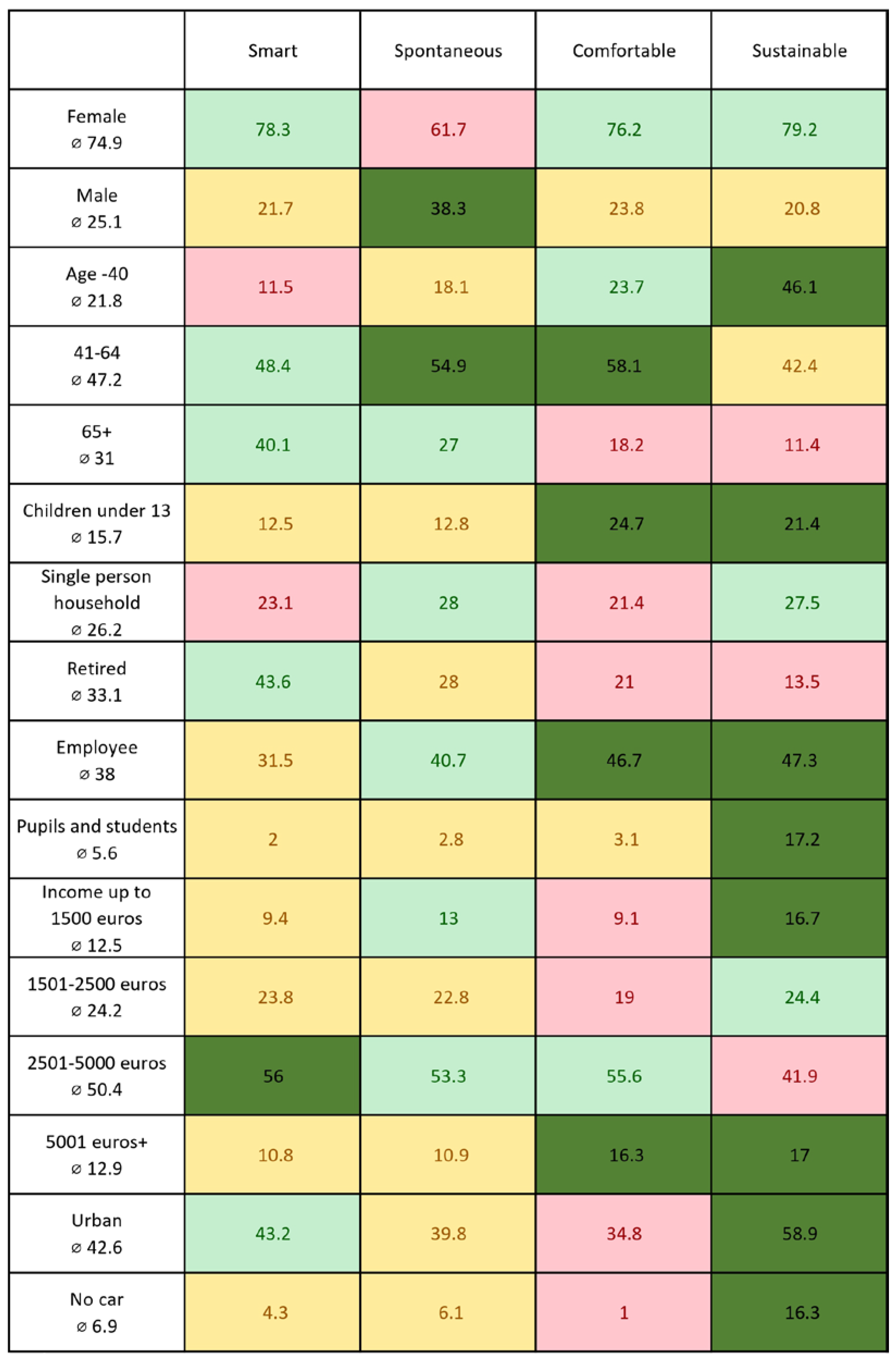
Appendix D
| Food Sector | Company | Interview Partner | Time |
|---|---|---|---|
| Bakery products | Kornkraft Schinkel | Production manager | 7 December 2021 |
| Bakery products | Backhaus Passade | Production manager | 6 January 2022 |
| Dairy products | Riecken Milch | Owner | 5 January 2022 |
| Dairy products | Rzehak Biohof | Owner | 12 January 2022 |
| Dairy products | Geestfrisch | Owner | 14 January 2022 |
| Dairy products | Hof Berg Dannau | Production manager | 20 January 2022 |
| Meat | Ahrens Fleisch | Owner | 12 January 2022 |
| Meat | Slowfood Kiel | Main speaker | 17 January 2022 |
| Fruits and vegetable | Biokiste Loubier | Owner | 13 January 2022 |
| Fruits and vegetable | Obstquelle Schuster | Owner | 20 January 2022 |
| Marketing | Kubitzberg Altenhof | Sales manager | 22 March 2022 |
| Fresh food | Hamfelder Hof | Production manager | 3 May 2022 |
| Foodsharing | Foodsharing Kiel | Main speaker | 21 June 2022 |
References
- Feedback EU. No Time to Waste: Why the EU Needs to Adopt Ambitious Legally Binding Food Waste Reduction Targets; Feedback EU: Rijswijk, The Netherlands, 2022; Available online: https://feedbackglobal.org/wp-content/uploads/2022/09/Feedback-EU-2022-No-Time-To-Waste-report-1.pdf (accessed on 19 December 2022).
- Kneafsey, M.; Maye, D.; Holloway, L.; Goodman, M. Geographies of Food; Bloomsbury Academic: London, UK, 2021. [Google Scholar]
- Oliveira, M.; Lago, A.; Magro, G. Food loss and waste in the context of the circular economy: A systematic review. J. Clean. Prod. 2021, 294, 126284. [Google Scholar] [CrossRef]
- Reynolds, C.; Soma, T.; Spring, C.; Lazell, J. Routledge Handbook of Food Waste; Routledge: London, UK, 2020. [Google Scholar]
- Blakeney, M. Food Loss and Food Waste—Causes and Solutions; Edward Elgar Publishing: Cheltenham, UK, 2019. [Google Scholar]
- Coudard, A.; Corbin, E.; de Koning, J.; Tukker, A.; Mogollón, J. Global water and energy losses from consumer avoidable food waste. J. Clean. Prod. 2021, 326, 129342. [Google Scholar] [CrossRef]
- Dou, Z.; Toth, J. Global primary data on consumer food waste: Rate and characteristics: A review. Resour. Conserv. Recycl. 2021, 168, 105332. [Google Scholar] [CrossRef]
- Chen, C.; Chaudhary, A.; Mathys, A. Nutritional and environmental losses embedded in global food waste. Resour. Conserv. Recycl. 2020, 160, 104912. [Google Scholar] [CrossRef]
- UNEP (United Nations Environment Programme). Food Waste Index Report 2021; UNEP: Nairobi, Kenya, 2021; Available online: https://www.unep.org/resources/report/unepfood-waste-index-report-2021 (accessed on 7 December 2022).
- Schmidt, T.; Schneider, F.; Leverenz, D.; Hafner, G. Lebensmittelabfälle in Deutschland—Baseline 2015; Thünen Report 71; Thünen Institute: Braunschweig, Germany, 2019; Available online: https://www.thuenen.de/media/publikationen/thuenen-report/Thuenen_Report_71.pdf (accessed on 19 December 2022).
- Roodhuyzen, D.; Luning, P.; Fogliano, V.; Steenbekkers, L. Putting together the puzzle of consumer food waste: Towards an integral perspective. Trends Food Sci. Technol. 2017, 68, 37–50. [Google Scholar] [CrossRef]
- Schanes, K.; Dobernig, K.; Gözet, B. Food waste matters—A systematic review of household food waste practices and their policy implications. J. Clean. Prod. 2018, 182, 978–991. [Google Scholar] [CrossRef]
- Boulet, M.; Hoek, A.; Raven, R. Towards a multi-level framework of household food waste and consumer behaviour: Untangling spaghetti soup. Appetite 2021, 156, 104856. [Google Scholar] [CrossRef]
- Okayama, T.; Watanabe, K.; Yamakawa, H. Sorting analysis of household food waste–Development of a methodology compatible with the aims of SDG12.3. Sustainability 2021, 13, 8576. [Google Scholar] [CrossRef]
- Jeswani, H.; Figueroa-Torres, G.; Azapagic, A. The extent of food waste generation in the UK and its environmental impacts. Sustain. Prod. Consum. 2021, 26, 532–547. [Google Scholar] [CrossRef]
- Galanakis, C. (Ed.) Food Waste Recovery—Processing Technologies and Industrial Techniques; Elsevier: Amsterdam, The Netherlands, 2015. [Google Scholar]
- Zhang, M.; Gao, M.; Yue, S.; Zheng, T.; Ma, X.; Wang, Q. Global trends and future prospects of food waste research: A bibliometric analysis. Environ. Sci. Pollut. Res. 2018, 25, 24600–24610. [Google Scholar] [CrossRef]
- Caldeira, C.; Laurentiis, V.; Corrado, S.; Holsteijn, F.; Sala, S. Quantification of food waste per product group along the food supply chain in the European Union: A mass flow analysis. Resour. Conserv. Recycl. 2019, 149, 479–488. [Google Scholar] [CrossRef]
- Canali, M.; Amani, P.; Aramyan, L.; Gheoldus, M.; Moates, G.; Östergren, K.; Silvennoinen, K.; Waldron, K.; Vittuari, M. Food waste drivers in Europe, from identification to possible interventions. Sustainability 2017, 9, 37. [Google Scholar] [CrossRef]
- Delley, M.; Brunner, T. Household food waste quantification: Comparison of two methods. Br. Food J. 2018, 120, 1504–1515. [Google Scholar] [CrossRef]
- Bovay, J.; Zhang, W. A century of profligacy? The measurement and evolution of food waste. Agric. Resour. Econ. Rev. 2019, 49, 375–409. [Google Scholar] [CrossRef]
- Priefer, C.; Jörissen, J.; Bräutigam, K. Food waste prevention in Europe—A cause-driven approach to identify the most relevant leverage points for action. Resour. Conserv. Recycl. 2016, 109, 155–165. [Google Scholar] [CrossRef]
- Huang, I.; Manning, L.; James, K.; Grigoriadis, V.; Millington, A.; Wood, V.; Ward, S. Food waste management: A review of retailers’ business practices and their implications for sustainable value. J. Clean. Prod. 2021, 285, 125484. [Google Scholar] [CrossRef]
- Principato, L. Food Waste at Consumer Level—A Comprehensive Literature Review; Springer: Cham, Switzerland, 2018. [Google Scholar]
- Sahakian, M.; Shenoy, M.; Soma, T.; Warabe, A.; Yagasa, R.; Premakumara, D.; Liu, C.; Favis, A.; Saloma, C. Apprehending food waste in Asia—Policies, practices and promisung trends. In Routledge Handbook of Food Waste; Reynolds, C., Soma, T., Spring, C., Lazell, J., Eds.; Routledge: London, UK, 2020; pp. 187–206. [Google Scholar]
- Bemmel, A.; Parizeau, K. Is it food or is it waste? The materiality and relational agency of food waste across the value chain. J. Cult. Econ. 2020, 13, 207–220. [Google Scholar] [CrossRef]
- Smith, A. The perfect storm—A history of food waste. In Routledge Handbook of Food Waste; Reynolds, C., Soma, T., Spring, C., Lazell, J., Eds.; Routledge: London, UK, 2020; pp. 37–54. [Google Scholar]
- European Union. Commission delegated decision (EU) 2019/1597 of 3 May 2019 supplementing Directive 2008/98/EC of the European Parliament and of the Council as regards a common methodology and minimum quality requirements for the uniform measurement of levels of food waste. Off. J. Eur. Union 2019, 62, L248/77–L248/85. Available online: https://eur-lex.europa.eu/legal-content/EN/TXT/PDF/?uri=CELEX:32019D1597&from=EN (accessed on 12 February 2023).
- Parizeau, K. Household food waste. In Routledge Handbook of Food Waste; Reynolds, C., Soma, T., Spring, C., Lazell, J., Eds.; Routledge: London, UK, 2020; pp. 129–143. [Google Scholar]
- Liu, C.; Chen, J. Takeaway food, waste, and their geographies in workplace. Geogr. Res. 2019, 58, 265–274. [Google Scholar] [CrossRef]
- Giordano, C.; Piras, S.; Boschini, M.; Falasconi, L. Are questionnaires a reliable method to measure food waste? A pilot study on Italian households. Br. Food J. 2018, 120, 2885–2897. [Google Scholar] [CrossRef]
- Szabó-Bódi, B.; Kasza, G.; Szakos, D. Assessment of household food waste in Hungary. Br. Food J. 2018, 120, 625–638. [Google Scholar] [CrossRef]
- Dooren, C.; Janmaat, O.; Snoek, J.; Schrijnen, M. Measuring food waste in Dutch households: A synthesis of three studies. Waste Manag. 2019, 94, 153–164. [Google Scholar] [CrossRef] [PubMed]
- Herzberg, R.; Schmidt, T.; Schneider, F. Characteristics and determinants of domestic food waste: A representative diary study across Germany. Sustainability 2020, 12, 4702. [Google Scholar] [CrossRef]
- Corrado, S.; Sala, S. Food waste accounting along global and European food supply chains: State of the art and outlook. Waste Manag. 2018, 79, 120–131. [Google Scholar] [CrossRef]
- WWF. Das große Wegschmeißen—Vom Acker bis zum Verbraucher; WWF: Berlin, Germany, 2015; Available online: https://www.wwf.de/fileadmin/fm-wwf/Publikationen-PDF/WWF_Studie_Das_grosse_Wegschmeissen.pdf (accessed on 19 December 2022).
- GfK. Systematische Erfassung des Lebensmittelabfalls der Privaten Haushalte in Deutschland—Schlussbericht 2020; GfK: Nuremburg, Germany, 2021; Available online: https://www.bmel.de/SharedDocs/Downloads/DE/_Ernaehrung/Lebensmittelverschwendung/GfK-Analyse-2020.pdf?__blob=publicationFile&v=4 (accessed on 19 December 2022).
- Bundesministerium für Ernährung. Ermittlung der Weggeworfenen Lebensmittelmengen und Vorschläge zur Verminderung der Wegwerfrate bei Lebensmitteln in Deutschland; Institut für Siedlungswasserbau, Wassergüte- und Abfallwirtschaft: Stuttgart, Germany, 2012; Available online: https://www.bmel.de/SharedDocs/Downloads/DE/_Ernaehrung/Lebensmittelverschwendung/Studie_Lebensmittelabfaelle_Langfassung.pdf?__blob=publicationFile&v=3 (accessed on 19 December 2022).
- Schmidt, T.; Schneider, F.; Claupein, E. Food Waste in Private Households in Germany; Thünen Working Paper 92a; Thünen Institute: Braunschweig, Germany, 2019; Available online: https://literatur.thuenen.de/digbib_extern/dn061022.pdf (accessed on 19 December 2022).
- Stancu, V.; Läthteenmäki, L. Consumer-related antecedents of food provisioning behaviors that promote food waste. Food Policy 2022, 108, 102236. [Google Scholar] [CrossRef]
- Annunziata, A.; Agovino, M.; Ferraro, A.; Mariani, A. Household food waste: A case study in southern Italy. Sustainability 2020, 12, 1495. [Google Scholar] [CrossRef]
- Parizeau, K.; Massow, M.; Martin, R. Household-level dynamics of food waste production and related beliefs, attitudes, and behaviours in Guelph, Ontario. Waste Manag. 2015, 35, 207–217. [Google Scholar] [CrossRef]
- Evans, D. Beyond the throwaway society: Ordinary domestic practice and a sociological approach to household food waste. Sociology 2012, 46, 41–56. [Google Scholar] [CrossRef]
- Santos, J.; Silveira, D.; Costa, M.; Duarte, R. Consumer behaviour in relation to food waste: A systematic literature review. Br. Food J. 2022, 124, 4420–4439. [Google Scholar] [CrossRef]
- Harvey, J.; Nica-Avram, G.; Smith, M.; Hibbert, S.; Muthuri, J. Mapping the landscape of consumer food waste. Appetite 2022, 168, 105702. [Google Scholar] [CrossRef]
- Principato, L.; Mattia, G.; Leo, A.; Pratesi, C. The household wasteful behaviour framework: A systematic review of consumer food waste. Ind. Mark. Manag. 2020, 93, 641–649. [Google Scholar] [CrossRef]
- Moraes, N.; Lermen, F.; Echeveste, M. A systematic literature review on food waste/loss prevention and minimization methods. J. Environ. Manag. 2021, 286, 112268. [Google Scholar] [CrossRef]
- Sunday, C.; Sowunmi, F.; Obayelu, O.; Awoyemi, A.; Omotayo, A.; Ogunniyi, A. Disentangling drivers of food waste in households: Evidence from Nigeria. Foods 2022, 11, 1103. [Google Scholar] [CrossRef] [PubMed]
- Koivupuru, H.; Hartikainen, H.; Silvennoinen, K.; Katajajuuri, J.; Heikintalo, N.; Reinikainen, A.; Jalkanen, L. Influence of socio-demographical, behavioural and attitudinal factors on the amount of avoidable food waste generated in Finnish households. Int. J. Consum. Stud. 2012, 36, 183–191. [Google Scholar] [CrossRef]
- González-Santana, R.; Blesa, J.; Frígola, A.; Esteve, M. Dimensions of household food waste focused on family and consumers. Crit. Rev. Food Sci. Nutr. 2020, 62, 2342–2354. [Google Scholar] [CrossRef] [PubMed]
- Chen, L.; House, L. Food lifestyle patterns among contemporary food shoppers. Int. J. Consum. Stud. 2021, 46, 944–963. [Google Scholar] [CrossRef]
- Wells, W. Psychographics: A critical review. J. Mark. Res. 1975, 12, 196–213. [Google Scholar] [CrossRef]
- Darden, W.; Ashton, D. Psychographic profiles of patronage preference groups. J. Retail. 1974, 50, 99–112. [Google Scholar]
- Oates, B.; Shufeldt, L.; Vaught, B. A psychographic study of the elderly and retail store attributes. J. Consum. Mark. 1996, 13, 14–27. [Google Scholar] [CrossRef]
- Grunert, K.; Brunsø, K.; Bisp, S. Food-Related Lifestyle; MAPP Working Paper No. 12; University of Aarhus: Aarhus, Denmark, 1993; Available online: https://pure.au.dk/portal/files/88/wp12.pdf (accessed on 21 December 2022).
- Aschemann-Witzel, J.; de Hooge, I.; Almli, V. My style, my food, my waste! Consumer food waste-related lifestyle segments. J. Retail. Consum. Serv. 2021, 59, 102353. [Google Scholar] [CrossRef]
- Thøgersen, J. Sustainable food consumption in the nexus between national context and private lifestyle: A multi-level study. Food Qual. Prefer. 2017, 55, 16–25. [Google Scholar] [CrossRef]
- Stancu, V.; Haugaard, P.; Lähteenmäki, L. Determinants of consumer food waste behaviour: Two routes to food waste. Appetite 2016, 96, 7–17. [Google Scholar] [CrossRef]
- Giordano, C.; Alboni, F.; Cicatiello, C.; Falasconi, L. Do discounted food products end up in a bin? An investigation into the link between deal-prone shopping behaviour and quantities of household food waste. Int. J. Consum. Stud. 2019, 43, 199–209. [Google Scholar] [CrossRef]
- Visschers, V.; Wickli, N.; Siegrist, M. Sorting out food waste behaviour: A survey on the motivators and barriers of self-reported amounts of food waste in households. J. Environ. Psychol. 2016, 45, 66–78. [Google Scholar] [CrossRef]
- Stefan, V.; van Herpen, E.; Tudoran, A.; Lähteenmäki, L. Avoiding food waste by Romanian consumers: The importance of planning and shopping routines. Food Qual. Prefer. 2013, 28, 375–381. [Google Scholar] [CrossRef]
- Grzeskowiak, S.; Sirgy, M.; Foscht, T.; Swoboda, B. Linking retailing experiences with life satisfaction: The concept of storey-type congruity with shopper’s identity. Int. J. Retail. Distrib. Manag. 2016, 44, 124–138. [Google Scholar] [CrossRef]
- Nilsson, E.; Gärling, T.; Marell, A.; Nordvall, A. Who shops groceries where and how?—The relationship between choice of store format and type of grocery shopping. Int. Rev.Retail. Distrib. Consum. Res. 2015, 25, 1–19. [Google Scholar] [CrossRef]
- Jürgens, U. Food waste and shopping behaviour—Quantitative household investigations based on local case studies from Germany. Die Erde 2022, 153, 28–59. [Google Scholar] [CrossRef]
- Aschemann-Witzel, J.; Hooge, I.; Amani, P.; Bech-Larsen, T.; Oostindjer, M. Consumer-related food waste: Causes and potential for action. Sustainability 2015, 7, 6457–6477. [Google Scholar] [CrossRef]
- World Resources Institute. Mapping Social Landscapes; WIR: Washington, DC, USA, 2018; Available online: https://www.wri.org/research/mapping-social-landscapes-guide-identifying-networks-priorities-and-values-restoration (accessed on 19 December 2022).
- Cherven, K. Mastering Gephi Network Visualization; Packt Publ.: Birmingham, UK, 2015. [Google Scholar]
- Holzer, B.; Stegbauer, C. (Eds.) Schlüsselwerke der Netzwerkforschung; Springer: Wiesbaden, Germany, 2019. [Google Scholar]
- Maggioni, I. What drives customer loyalty in grocery retail? Exploring shoppers’ perceptions through associative networks. J. Retail. Consum. Serv. 2016, 33, 120–126. [Google Scholar] [CrossRef]
- Brinkley, C. Visualizing the social and geographical embeddedness of local food systems. J. Rural. Stud. 2017, 54, 314–325. [Google Scholar] [CrossRef]
- Hanssen, O.; Syversen, F.; Stø, E. Edible food waste from Norwegian households-detailed food waste composition analysis among households in two different regions in Norway. Resour. Conserv. Recycl. 2016, 109, 146–154. [Google Scholar] [CrossRef]
- Aschemann-Witzel, J. Helping you to waste less? Consumer acceptance of food marketing offers targeted to food-related lifestyle segments of consumers. J. Food Prod. Mark. 2018, 24, 522–538. [Google Scholar] [CrossRef]
- Young, C.; Russell, S.; Robinson, C.; Chintakayala, P. Sustainable retailing—Influencing consumer behaviour on food waste. Bus. Strategy Environ. 2018, 27, 1–15. [Google Scholar] [CrossRef]
- Welch, D.; Swaffield, J.; Evans, D. Who’s responsible for food waste? Consumers, retailers and the food waste discourse coalition in the United Kingdom. J. Consum. Cult. 2021, 21, 236–256. [Google Scholar] [CrossRef]
- Augustin, M.; Sanguansri, L.; Fox, E.; Cobiac, L.; Cole, M. Recovery of wasted fruit and vegetables for improving sustainable diets. Trends Food Sci. Technol. 2020, 95, 75–85. [Google Scholar] [CrossRef]
- Aschemann-Witzel, J.; de Hooge, I.; Almli, V.; Oostindjer, M. Fine-tuning the fight against food waste. J. Macromarketing 2018, 38, 168–184. [Google Scholar] [CrossRef]
- Ajzen, I. The theory of planned behavior. Organ. Behav. Hum. Decis. Process. 1991, 50, 179–211. [Google Scholar] [CrossRef]
- Falasconi, L.; Cicatiello, C.; Franco, S.; Segrè, A.; Setti, M.; Vittuari, M. Such a shame! A study on self-perception of household food waste. Sustainability 2019, 11, 270. [Google Scholar] [CrossRef]
- Verain, M.; Bartels, J.; Dagevos, H.; Sijtsema, S.; Onwezen, M.; Antonides, G. Segments of sustainable food consumers: A literature review. Int. J. Consum. Stud. 2012, 36, 123–132. [Google Scholar] [CrossRef]
- Di Talia, E.; Simeone, M.; Scarpato, D. Consumer behaviour types in household food waste. J. Clean. Prod. 2019, 214, 166–172. [Google Scholar] [CrossRef]
- Richter, B. Knowledge and perception of food waste among German consumers. J. Clean. Prod. 2017, 166, 641–648. [Google Scholar] [CrossRef]
- Graham-Rowe, E.; Jessop, D.; Sparks, P. Identifying motivations and barriers to minimising household food waste. Resour. Conserv. Recycl. 2014, 84, 15–23. [Google Scholar] [CrossRef]
- McCarthy, B.; Liu, H. Waste not, want not—Exploring green consumers’ attitudes towards wasting edible food and actions to tackle food waste. Br. Food J. 2017, 119, 2519–2531. [Google Scholar] [CrossRef]
- Chen, M. Integrating the extended theory of planned behavior model and the food-related routines to explain food waste behavior. Br. Food J. 2023, 125, 645–661. [Google Scholar] [CrossRef]
- Vonthron, S.; Perrin, C.; Soulard, C. Foodscape: A scoping review and a research agenda for food security-related studies. PLoS ONE 2020, 15, e0233218. [Google Scholar] [CrossRef]
- Amicarelli, V.; Tricase, C.; Spada, A.; Bux, C. Households’ food waste behavior at local scale: A cluster analysis after the COVID-19 lockdown. Sustainability 2021, 13, 3283. [Google Scholar] [CrossRef]
- Iranmanesh, M.; Ghobakhloo, M.; Nilashi, M.; Tseng, M.; Senali, M.; Abbasi, G. Impacts of the COVID-19 pandemic on household food waste behaviour: A systematic review. Appetite 2022, 176, 106127. [Google Scholar] [CrossRef] [PubMed]
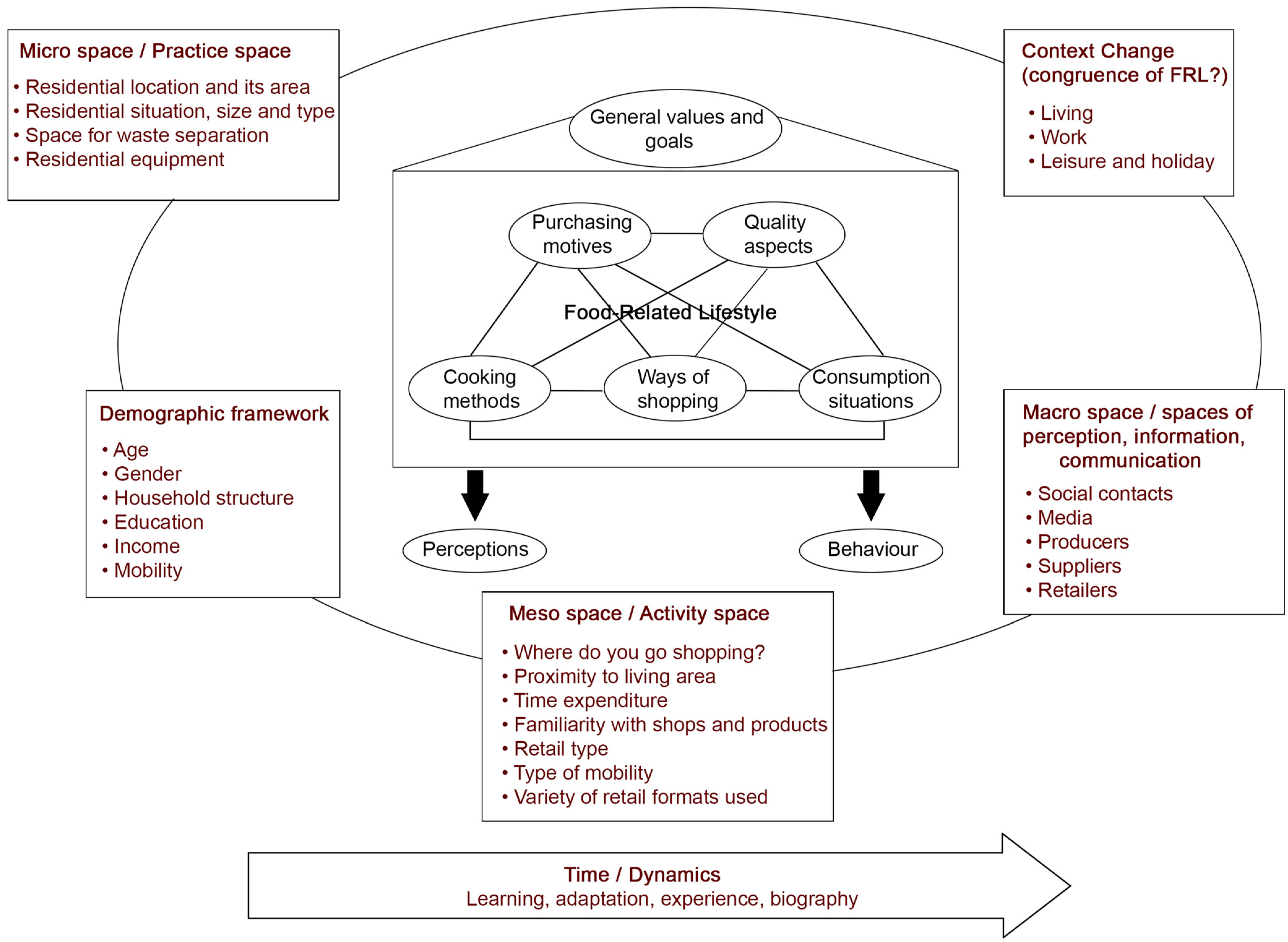
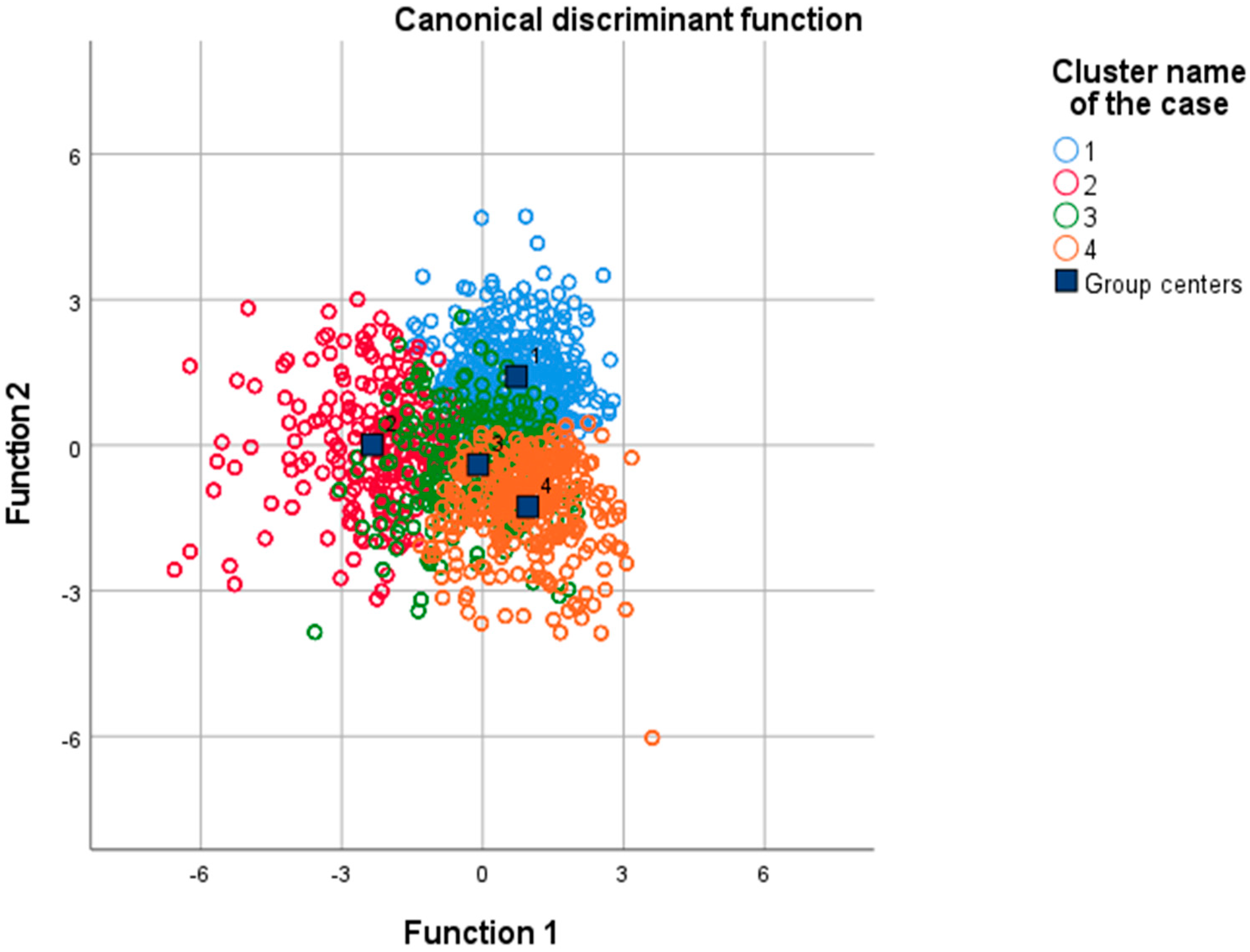
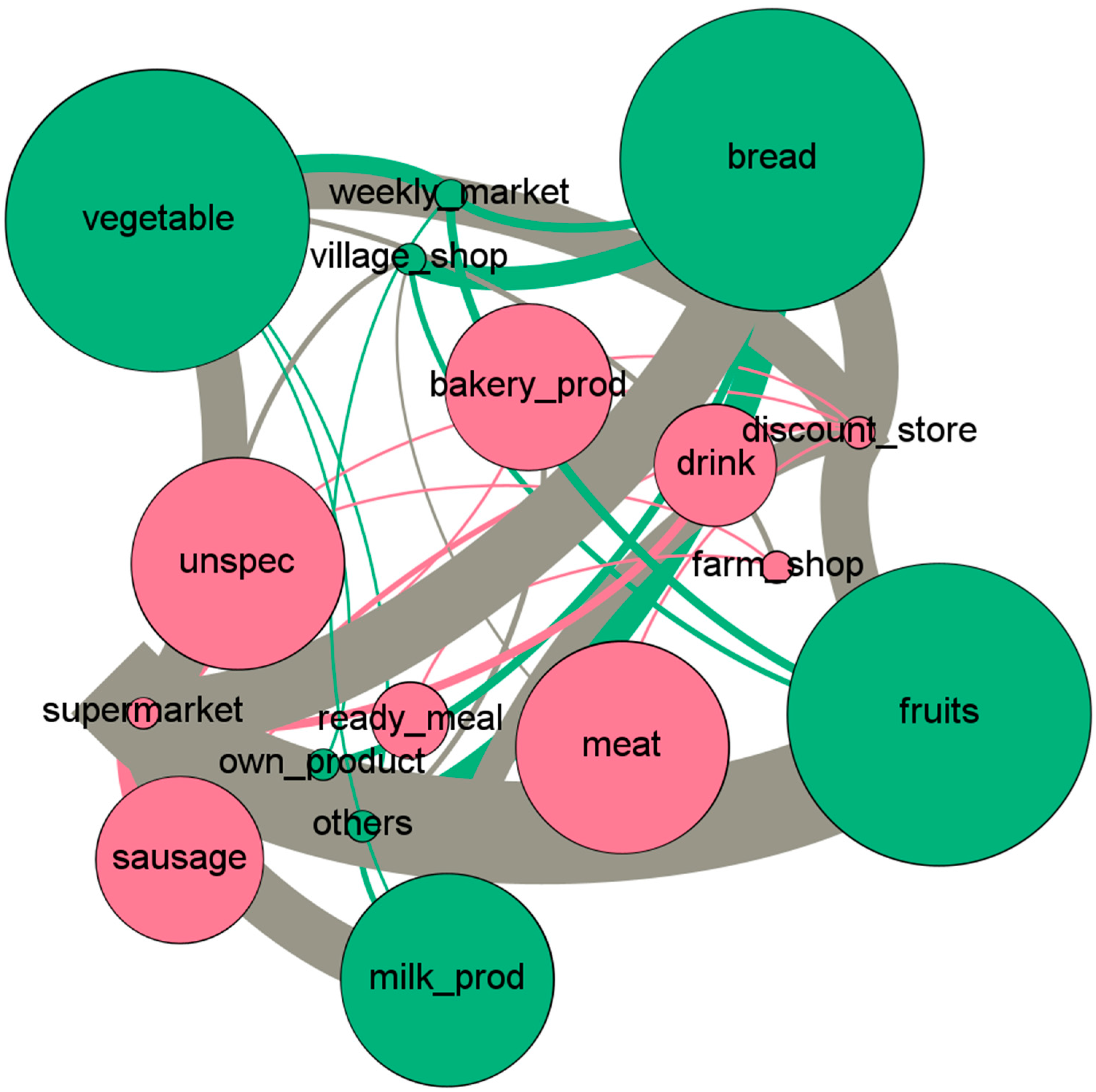
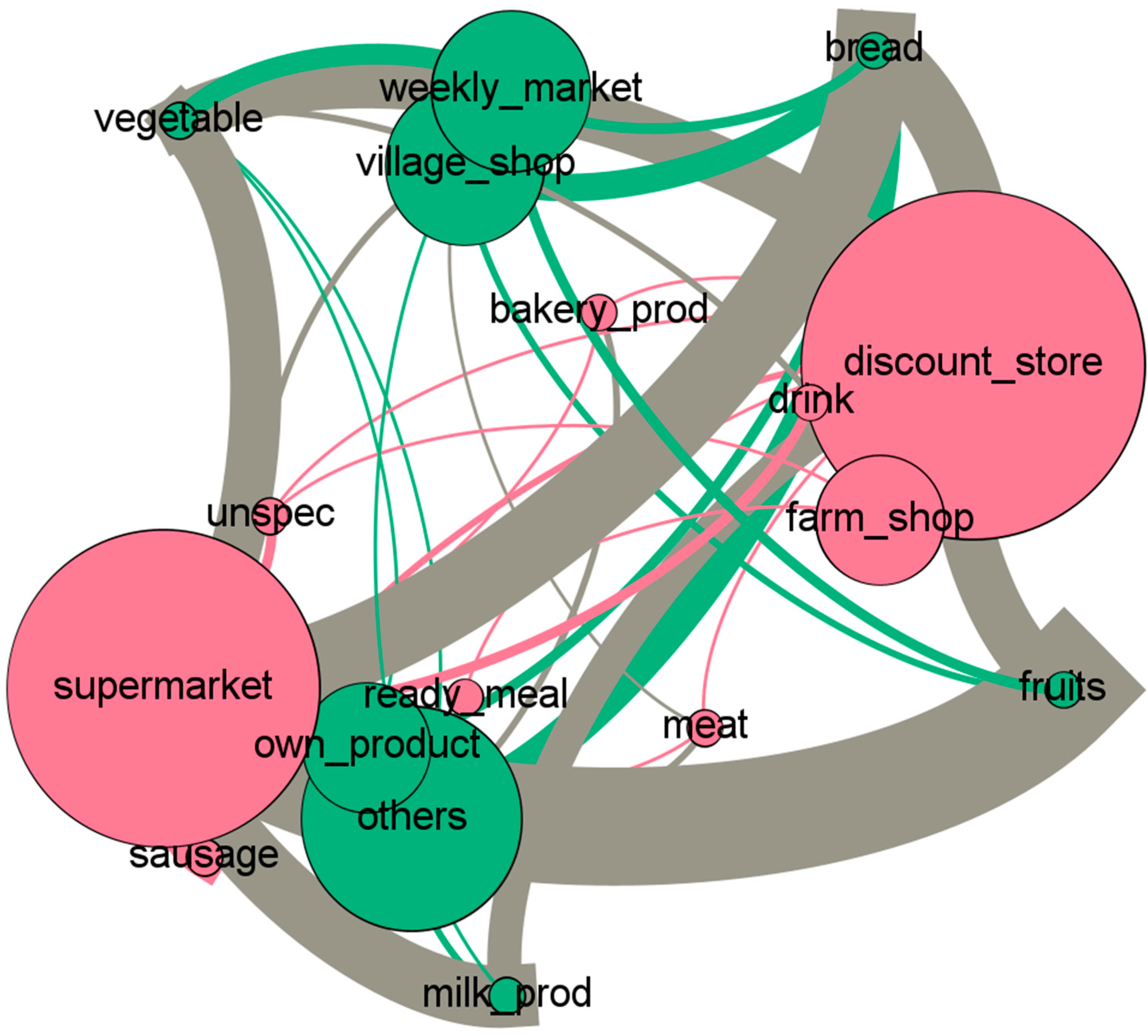
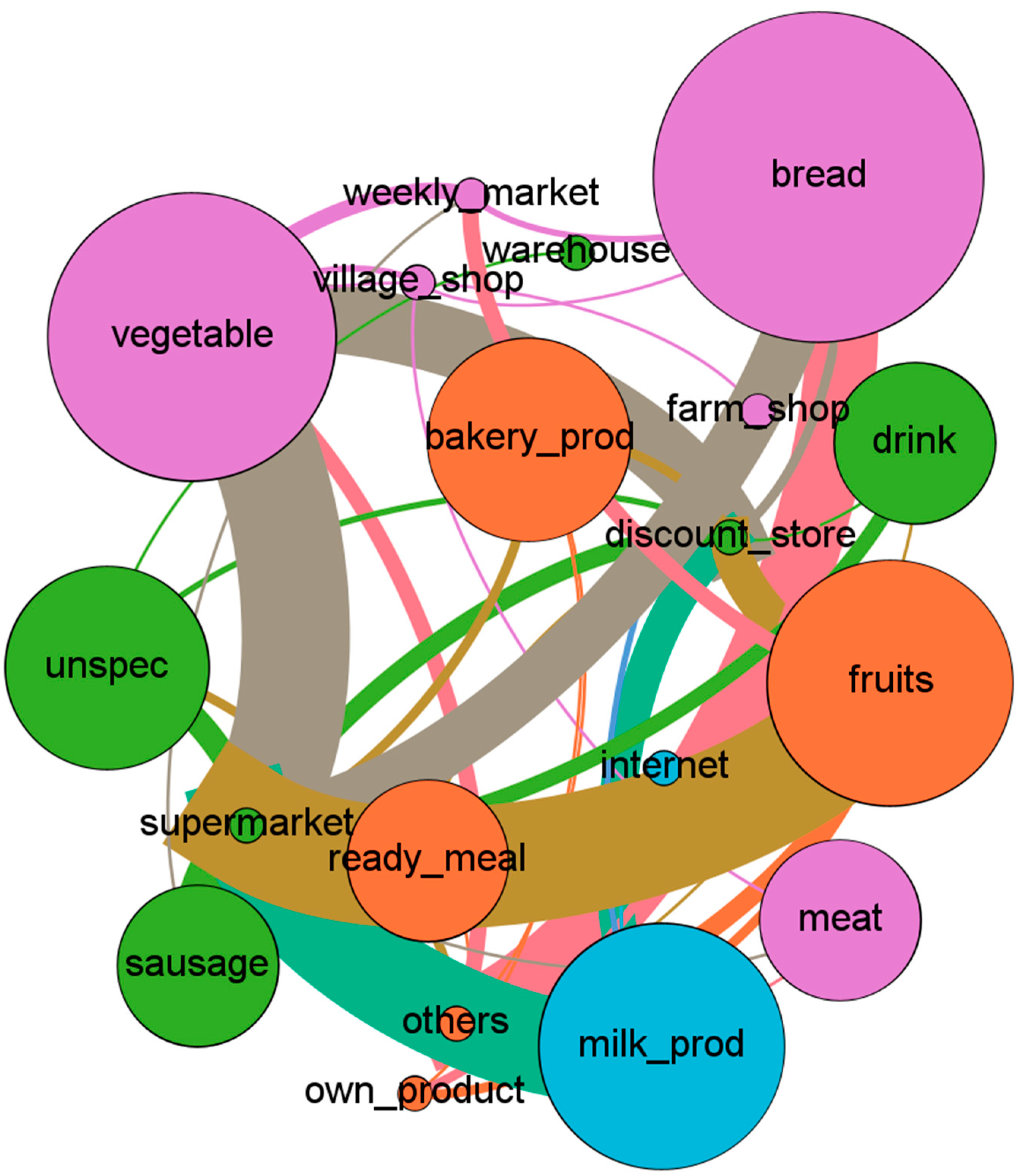
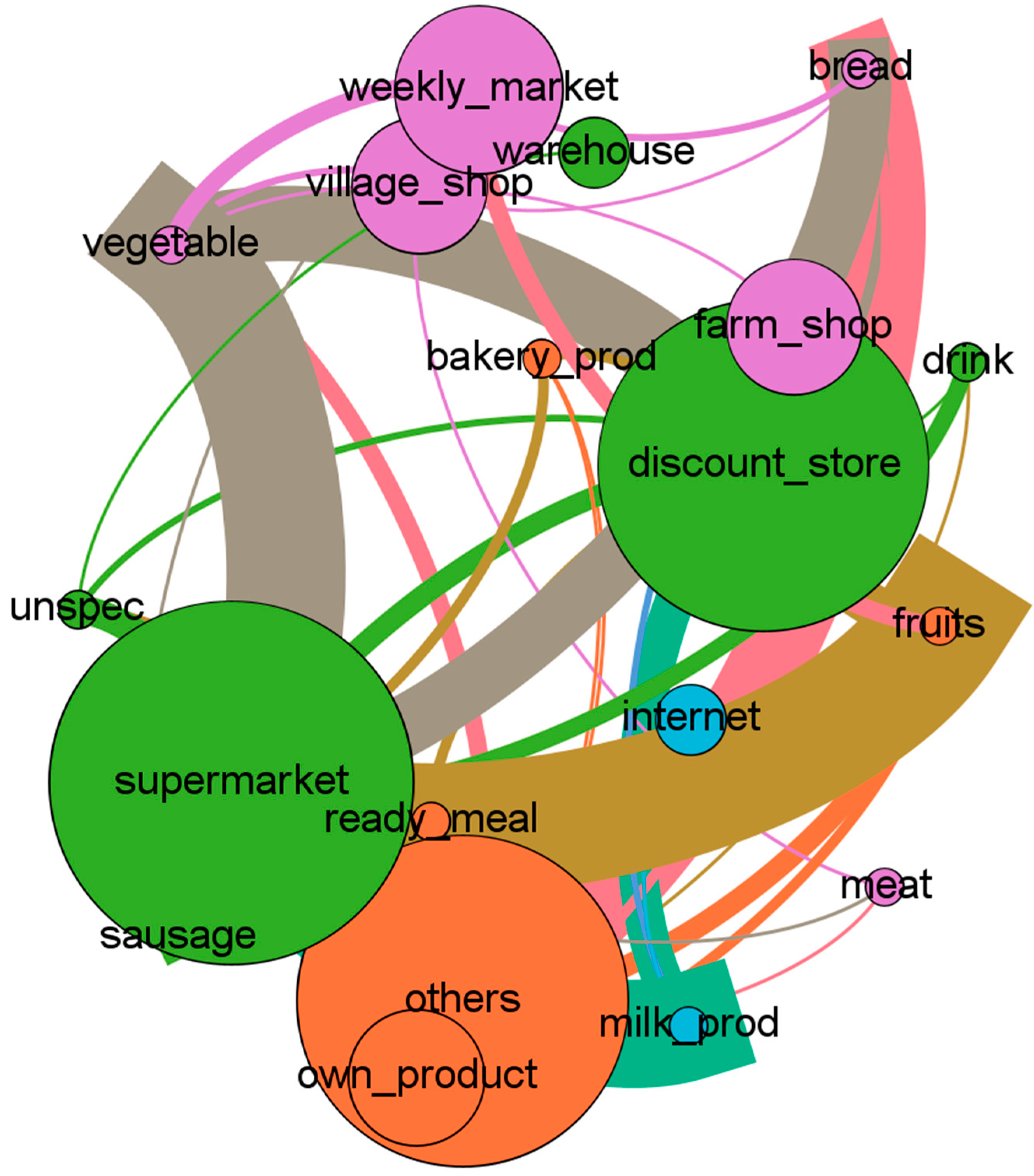
| Community | Population Size | Number of Households | Number of Participating Households | Response in % |
|---|---|---|---|---|
| Achterwehr | 1042 | 450 | 91 | 20.2 |
| Bokel | 600 | 250 | 38 | 15.2 |
| Brodersby | 672 | 281 | 86 | 30.6 |
| Bünsdorf | 610 | 300 | 49 | 16.3 |
| Dannau | 597 | 290 | 37 | 12.8 |
| Gettorf | 7602 | 3400 | 320 | 9.4 |
| Mettenhof | 19,897 | 596 | 40 | 6.7 |
| Neuwittenbek | 1113 | 500 | 114 | 22.8 |
| Osdorf | 2500 | 1160 | 117 | 10.1 |
| Schinkel | 1015 | 450 | 101 | 22.4 |
| Todenbüttel | 1027 | 475 | 66 | 13.9 |
| Warder | 698 | 200 | 42 | 21.0 |
| Online | n.a. | n.a. | 357 | n.a. |
| Community | Proportion Female in Basic Population | Proportion Female in Sample | Share 65plus in Basic Population | Share 65plus in Sample |
|---|---|---|---|---|
| Achterwehr | 49.7 | 67.4 | 19.4 | 32.6 |
| Bokel | 49.1 | 68.4 | 20.4 | 24.3 |
| Brodersby | 53.0 | 72.3 | 36.0 | 41.5 |
| Bünsdorf | 49.5 | 71.7 | 19.0 | 40.8 |
| Dannau | 50.0 | 75.7 | 18.4 | 27.0 |
| Gettorf | 51.2 | 73.5 | 22.6 | 42.5 |
| Mettenhof | 51.1 | 66.7 | 18.7 | 48.7 |
| Neuwittenbek | 51.4 | 78.8 | 24.3 | 42.1 |
| Osdorf | 50.4 | 75.0 | 19.2 | 33.6 |
| Schinkel | 50.7 | 71.9 | 21.4 | 40.4 |
| Todenbüttel | 49.4 | 61.5 | 19.0 | 33.3 |
| Warder | 50.4 | 69.0 | 30.1 | 26.8 |
| Online | n.a. | 84.2 | n.a. | 7.2 |
| Food Category | Smart | Spontaneous | Comfortable | Sustainable |
|---|---|---|---|---|
| Baked goods | 2.9 | 1.8 | 2.6 | 3.7 |
| Bread | 25.8 | 28.0 | 26.1 | 19.9 |
| Dairy products | 9.7 | 13.5 | 12.9 | 15.2 |
| Drinks | 2.4 | 2.5 | 1.8 | 2.4 |
| Fruit | 21.3 | 22.2 | 19.9 | 21.5 |
| Meat | 0.8 | 2.9 | 1.2 | 1.0 |
| Ready-made products | 2.9 | 0.4 | 2.1 | 1.7 |
| Sausage | 8.2 | 8.4 | 7.0 | 6.4 |
| Vegetables | 20.3 | 16.4 | 19.9 | 23.2 |
| Others | 5.8 | 4.0 | 6.5 | 5.1 |
| N-answers | 380 | 275 | 341 | 297 |
| Reason for Disposal | Smart | Spontaneous | Comfortable | Sustainable |
|---|---|---|---|---|
| Forgotten | 11.7 | 10.9 | 11.0 | 7.8 |
| Mispurchase | 1.8 | 0.8 | 0.6 | 0.6 |
| Optics | 3.4 | 3.5 | 2.5 | 1.9 |
| Packaging size | 2.3 | 1.2 | 2.0 | 1.3 |
| Shelf life | 7.8 | 10.9 | 8.5 | 5.2 |
| Spoiled | 57.0 | 58.6 | 56.5 | 70.6 |
| Taste | 3.4 | 1.6 | 3.4 | 2.3 |
| Too hard | 7.0 | 10.9 | 11.9 | 6.5 |
| Others | 5.7 | 1.6 | 3.7 | 3.9 |
| N-answers | 386 | 256 | 354 | 309 |
| Source of Origin | Smart | Spontaneous | Comfortable | Sustainable |
|---|---|---|---|---|
| Alternatives | 13.1 | 14.2 | 13.2 | 8.6 |
| Hereunder village shop | 3.2 | 5.4 | 6.3 | 1.3 |
| Hereunder farm shop | 4.0 | 2.5 | 3.3 | 2.3 |
| Hereunder weekly market | 5.9 | 6.3 | 3.6 | 5.0 |
| Discounter | 23.4 | 28.7 | 22.1 | 21.1 |
| Own product | 5.1 | 2.5 | 4.3 | 4.0 |
| Specialty shops/others | 10.5 | 8.3 | 9.6 | 15.5 |
| Supermarket | 47.8 | 46.3 | 50.8 | 50.8 |
| N-answers | 372 | 240 | 303 | 303 |
| Source of Origin | Smart | Spontaneous | Comfortable | Sustainable |
|---|---|---|---|---|
| Alternatives | 19.6 | 11.2 | 18.4 | 24.5 |
| Discounter | 26.2 | 34.1 | 24.8 | 25.4 |
| Specialty shops | 16.3 | 15.0 | 15.9 | 12.0 |
| Supermarket | 36.4 | 37.5 | 39.5 | 35.8 |
| Others | 1.4 | 2.2 | 1.4 | 2.3 |
| N-answers | 1274 | 722 | 985 | 989 |
| Disposal Category | Discounter | Village Shop | Own Product | Farm Shop | Super-Market | Weekly Market | Other (Specialty Shops) |
|---|---|---|---|---|---|---|---|
| Forgotten | 10.7 | 8.7 | 20.9 | 9.7 | 6.6 | 3.7 | 3.6 |
| Mispurchase | 1.1 | 0 | 0 | 0 | 0.8 | 1.9 | 0 |
| Optics | 1.1 | 2.2 | 0 | 0 | 2.8 | 7.4 | 2.2 |
| Packaging size | 2.2 | 0 | 0 | 0 | 2.6 | 1.9 | 0.7 |
| Shelf life | 11.4 | 2.2 | 0 | 6.5 | 6.6 | 3.7 | 1.4 |
| Spoiled | 64.6 | 58.7 | 41.9 | 74.2 | 71.4 | 63.0 | 57.6 |
| Taste | 2.6 | 0 | 7.0 | 0 | 2.0 | 5.6 | 2.9 |
| Too hard | 3.7 | 23.9 | 18.6 | 6.5 | 4.9 | 11.1 | 20.9 |
| Other | 2.6 | 4.3 | 11.6 | 3.2 | 2.3 | 1.9 | 10.8 |
| N-answers = 1.193 | 271 | 46 | 43 | 31 | 609 | 54 | 139 |
| N-answers in % | 22.7 | 3.9 | 3.6 | 2.6 | 51.0 | 4.5 | 11.7 |
| Frequency of Disposal | Smart | Spontaneous | Comfortable | Sustainable |
|---|---|---|---|---|
| Daily | 9.5 | 7.0 | 11.3 | 6.1 |
| Up to weekly | 21.0 | 34.8 | 35.4 | 22.3 |
| Several times a month | 16.4 | 15.8 | 19.9 | 19.9 |
| Monthly | 11.0 | 14.0 | 12.7 | 19.3 |
| More seldom | 33.4 | 25.6 | 18.9 | 30.4 |
| Never | 8.6 | 2.8 | 1.7 | 2.0 |
| N-answers | 347 | 215 | 291 | 296 |
| Structural Data | Smart | Spontaneous | Comfortable | Sustainable | N-Answers | Kruskal–Wallis Test 2 |
|---|---|---|---|---|---|---|
| No car in the household | 4.3 | 6.1 | 1.0 | 16.3 | 79 | <0.001 1 |
| Shopping by bike | 22.1 | 15.6 | 12.2 | 25.9 | 286 | <0.001 |
| Shopping on foot | 180 | 20.9 | 13.4 | 26.1 | 287 | <0.001 |
| Shopping by car | 59.3 | 62.1 | 74.1 | 47.2 | 887 | <0.001 |
| Daily shopping | 2.3 | 3.7 | 3.1 | 2.0 | 31 | <0.001 |
| Shopping three to four times a week | 17.7 | 30.6 | 18.8 | 15.2 | 128 | <0.001 |
| Shopping twice a week | 53.4 | 45.8 | 45.7 | 49.5 | 567 | <0.001 |
| Shopping once a week | 23.1 | 16.2 | 28.3 | 32.3 | 295 | <0.001 |
Disclaimer/Publisher’s Note: The statements, opinions and data contained in all publications are solely those of the individual author(s) and contributor(s) and not of MDPI and/or the editor(s). MDPI and/or the editor(s) disclaim responsibility for any injury to people or property resulting from any ideas, methods, instructions or products referred to in the content. |
© 2023 by the author. Licensee MDPI, Basel, Switzerland. This article is an open access article distributed under the terms and conditions of the Creative Commons Attribution (CC BY) license (https://creativecommons.org/licenses/by/4.0/).
Share and Cite
Jürgens, U. Does Food Shopping Behaviour Determine Food Waste Vulnerability in Private Households? Quantitative Analysis on Case Studies from Germany. Sustainability 2023, 15, 4818. https://doi.org/10.3390/su15064818
Jürgens U. Does Food Shopping Behaviour Determine Food Waste Vulnerability in Private Households? Quantitative Analysis on Case Studies from Germany. Sustainability. 2023; 15(6):4818. https://doi.org/10.3390/su15064818
Chicago/Turabian StyleJürgens, Ulrich. 2023. "Does Food Shopping Behaviour Determine Food Waste Vulnerability in Private Households? Quantitative Analysis on Case Studies from Germany" Sustainability 15, no. 6: 4818. https://doi.org/10.3390/su15064818
APA StyleJürgens, U. (2023). Does Food Shopping Behaviour Determine Food Waste Vulnerability in Private Households? Quantitative Analysis on Case Studies from Germany. Sustainability, 15(6), 4818. https://doi.org/10.3390/su15064818






